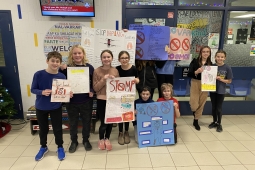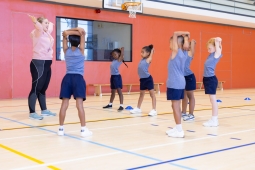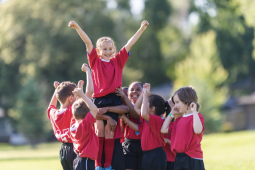Teaching Consent Can Be Tricky, But It Doesn’t Have to Be!

One of the things that truly frustrates me is when people say, "Consent is simple. It is either a yes or a no." A few years ago, an award-winning media campaign carried this exact message.
The reality is that consent is far from simple, and young people understand this. There are many factors that complicate consent, such as uncertainty, power dynamics, peer pressure, and social norms. These all interfere with autonomy and clear communication. If we tell young people that consent is simple, we are essentially saying that we do not acknowledge or empathize with their confusion.
We tell kids to say no, but we fail to explain why it may be difficult for them to do so. As a result, they end up blaming themselves for not speaking up. We tell them to look for an enthusiastic yes, but we do not show them what that looks like—or, more importantly, what a lack of enthusiasm looks like. Often, they fail to recognize it when it happens.
We tell kids to avoid doing things they do not want to do, but we do not teach them how to identify what they want or do not want, especially when that is unclear. And it is often unclear.
We encourage kids to be nice, polite, and avoid conflict their entire lives, and then we expect them to suddenly and magically assert themselves confidently in high-stakes situations—the very situations that can be the most challenging they have ever encountered.
Everywhere, young people are grappling with issues like gendered violence, sexual harassment, and assault. They are confused about what consent and assault really mean, and they struggle to understand their rights to bodily autonomy. At the same time, they internalize harmful myths and societal models, which lead them to blame themselves and remain silent.
Teaching Consent Skills
After laying out some of the many complexities of consent, it may seem even more intimidating to teach it. But if we focus on the skills that make consent easier—what I call Consent Skills—and prioritize creating positive interactions, teaching consent can become straightforward, effective, and even enjoyable.
As my co-author, Marcia Baczynski, and I mention in our book Creating Consent Culture: A Handbook for Educators (Jessica Kingsley Publishers, 2022):
"Fighting an old paradigm can be overwhelming and exhausting. But creating a new culture is fun, inspiring, and exciting."
So, how can we do this? By guiding your students through simple, fun exercises, you can help them learn and practice the consent skills that will enable them to navigate social interactions more effectively. Practicing these skills in a safe, controlled environment will help young people use them more readily when they face higher-stakes situations.
Here are the key consent skills to focus on:
- What to do when you are unsure (and understanding that it is normal to be uncertain)
- How to hear "no" graciously
- How to say "no" confidently (and understanding why that might be hard)
- How to avoid miscommunications
- How to check in with yourself to know whether you are a yes or a no
- How to ask for what you want clearly
Discussions to Build Empathy
Before diving into these skills, it is essential to have foundational discussions about why consent can be challenging. Ask your students why it might be hard for someone to say no and create a list on the board. Then, ask them why it might be hard to hear a no, and build another list together.
When I teach these skills, I always start with brief discussions to explore how students are feeling and build empathy for the challenges most people face when setting or respecting boundaries. Then, we move on to learning and practicing the skill.

An Example: Learning to Hear "No" Graciously
Let me walk you through one of my favorite exercises for teaching students how to hear "no" graciously. This skill—which includes understanding different versions of "no" and recognizing a lack of enthusiasm—is, in my opinion, the most critical consent skill.
When I teach students (or adults) to hear no graciously, I start by helping them understand and empathize with why it is sometimes hard for people to say no. I emphasize that when someone offers a clear "no," it is actually a gift that should be appreciated.
Then, I teach them to do something that may seem radical at first: I encourage them to thank someone when they say no. This is usually met with reactions like, "This feels weird!" or "This is awkward!" And I get it. Most of us are not accustomed to appreciating someone else’s boundary. However, there are many advantages to learning this response. Not only does it create safety for the person who has expressed their boundary, but it also fosters a smoother transition from hearing "no" to understanding that maintaining a connection is more important than getting what you want in the moment.
Teachers are often amazed at how quickly students move from "This is weird!" to "Hey, thanks for letting me know," as though they had been doing it their whole lives.
When we are thanked and appreciated for expressing our boundaries, it helps undo a lifetime of fearing retaliation or rejection for saying no. It creates safety, encourages us to be authentic, and builds confidence in exploring what we truly want.
I challenge you to try this in your own life. Look for an opportunity to thank someone when they express a boundary or say no, and pay attention to their reaction.
Here is how the exercise works in practice:
I begin by telling the students that we will discuss touch but will not actually touch each other. I explain that they are welcome to sit out if they feel uncomfortable, though they will get more out of the activity if they participate.
Next, I ask them to break into pairs and assign roles: One person is A, and the other is B. A’s task is simply to ask, "Can I hug you?" while B’s job is to say, "No." That’s it—just "no" and nothing else. Afterward, they swap roles and repeat the exercise.
I often notice that participants laugh, apologize, or explain why they are saying no, even though I specifically told them to just say "no." This naturally leads into a discussion on why saying and hearing "no" can be difficult.
Next, I lead them through a follow-up exercise, which starts in the same way but ends with A saying, "Thank you," when B says "no." I ask the students how this second exercise felt compared to the first. We discuss how thanking someone for saying "no" can create safety and deepen authentic connection.
Finally, I encourage them to get up and move around the room, asking for hugs, saying no, and practicing thanking each other in ways that feel natural to them. It is amazing to witness how quickly students become comfortable with this new skill!
You can watch a short clip of this exercise here:
Learning and Unlearning
While teaching these practical skills, we are also engaging in important unlearning. As we grow, we unconsciously absorb cultural norms that make interactions more complicated.
For instance, in a 2005 BBC social experiment, five-year-olds were split into boys and girls. Each group was introduced to a friendly woman who made them lemonade—but she secretly added salt instead of sugar. When the boys tasted the lemonade, they immediately spat it out and said it tasted terrible. Meanwhile, the girls politely pretended to sip the lemonade, claiming they were not thirsty or even complimenting the taste. This experiment demonstrates how unconscious conditioning can lead to significant differences in how we advocate for ourselves and set boundaries. We have all been taught things that need to be unlearned.
The Freeze Response
One of the most damaging misconceptions to unlearn is the shame associated with not saying "no." I encourage you to teach your students about the freeze response, which is the most common autonomic reaction to sexual harassment and assault.
The freeze response occurs just as quickly as the fight-or-flight response—within 15 milliseconds—and is beyond our conscious control. Many survivors of harassment or assault do not understand that their body may have chosen the freeze response, leading them to feel ashamed for not reacting as they think they should. Understanding the science behind this response can help survivors release their shame and self-blame.
Conclusion
Young people deserve the tools and skills necessary to have healthy, satisfying, and pleasurable relationships. This means providing comprehensive sex and relationship education, which includes learning and practicing consent skills, and understanding why these skills are so important.
Teaching consent might feel challenging at first, but it can be done in fun, interactive, trauma-informed, and age-appropriate ways that are also highly effective. It is wonderful that various curricula across Canada are starting to include consent education, but how we teach it matters. I have only scratched the surface here by offering one example of a fun and interactive way to teach consent skills, but there are many more. I hope you will try them out!
Resources:
Books
- Creating Consent Culture: A Handbook for Educators by Marcia Baczynski and Erica Scott
- Real Talk About Sex and Consent by Cheryl M. Bradshaw
- Legitimate Sexpectations: The Power of Sex-Ed by Katrina Marson
Podcasts
Articles
- Freezing during SA
- Neurobiological responses during SA
- Societies Without Rape: Analysis of Peggy Reeves' Study
- My Ally Bill of Responsibilities - Home Page
- Trauma response map by Kai Cheng Thom
Organizations








